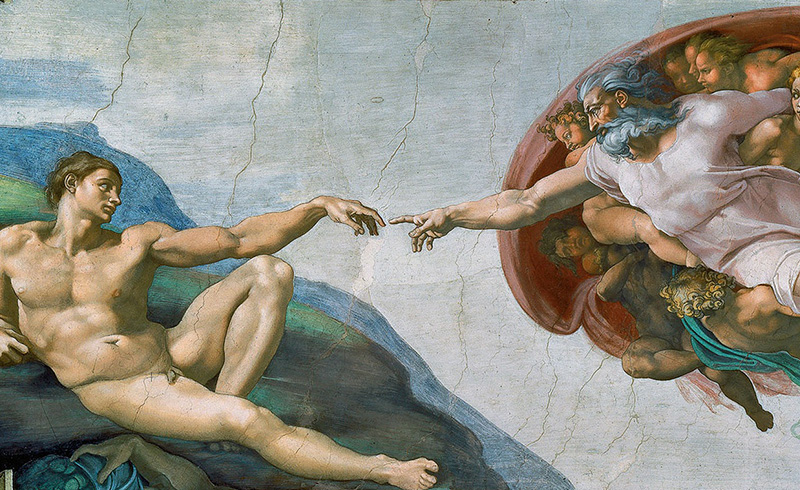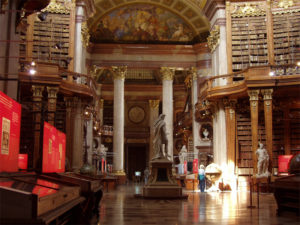
September 22, 2016
Haydn’s The Creation: The Sistine Chapel of Music

On September 29 and October 1 & 2, 2016, the Houston Symphony performs Haydn’s masterpiece, The Creation. Learn more about the concert here.
When it comes to grand choral works from the classical era, most symphony fans will immediately think of Mozart’s Requiem. Full of darkness, terror and passages of transcendent beauty, this is one of the few pieces of classical music that has become famous enough to crop up in mainstream pop culture every so often. While Mozart’s final, unfinished masterpiece certainly deserves its fame, it has perhaps overshadowed another great choral piece of the same era that in many respects is its polar opposite and equal: Haydn’s The Creation.
Whereas Mozart’s Requiem is a pessimistic work focused on death and the end of the world, Haydn’s The Creation provides listeners with a radiant vision of the Genesis creation story similar to that depicted in Michelangelo’s frescoes for the Sistine Chapel. Mozart’s Requiem is music of darkness; Haydn’s The Creation, of light. Indeed, one of the most famous moments of Haydn’s The Creation is when the chorus says, “and there was light.”
https://www.youtube.com/watch?v=wHqb-WYs6ZM&t=9m44s
Haydn finished The Creation in 1798, nearly seven years after his friend Mozart’s death. Despite their age difference (Haydn was almost 24 years older than Mozart), the two composers had been lifelong friends who frequently took inspiration from each other’s music. They would often gather with other friends to play chamber music in Mozart’s apartment in Vienna, Mozart on viola and Haydn on violin. Mozart famously honored Haydn by dedicating a set of six groundbreaking string quartets to his avuncular musical mentor, writing “A father [Mozart] who had resolved to send his children [the string quartets] out into the great world took it to be his duty to confide them to the protection and guidance of a very celebrated Man, especially when the latter by good fortune was at the same time his best Friend.”

Mozart may have even played a role in inspiring Haydn to compose The Creation. In 1789, Mozart produced a version of Handel’s Messiah with updated orchestrations. This may have been Haydn’s first exposure to Handel’s famous oratorio, which had been premiered in Dublin decades earlier and was still relatively unknown outside Britain. He certainly heard it and other oratorios by Handel during the celebrated trips to London he took after Mozart’s untimely death.
Handel defined the genre of oratorio for all composers who came after him. Oratorios were grand works for chorus, soloists and orchestra that told biblical stories through music. Haydn was greatly moved by Handel’s Messiah, and was determined to make his own contribution to the genre of oratorio. Any music lover who has enjoyed Handel’s Messiah will be delighted by Haydn’s The Creation; perhaps the main reason it is less famous is that The Creation has not been incorporated into any annual holiday tradition.
Haydn was a devoutly religious man; at the end of every score he finished he wrote “Laus Deo,” Latin for “praise be to God.” He himself saw The Creation as his greatest masterpiece, as the culmination of his life’s work as a composer. His depiction of the creation of the world, however, reflects the scriptural interpretations of contemporary Enlightenment era culture. Whatever one’s religious beliefs (or lack thereof), Haydn’s The Creation engages with fascinating philosophical ideas that remain as relevant as ever.

Many of these ideas are apparent in the text of The Creation. Unlike Mozart’s Requiem, which uses a traditional Latin text, or Handel’s Messiah, which draws directly from the Bible, Haydn’s The Creation uses an original text inspired by both the Bible and Milton’s Paradise Lost. The ultimate form of this text was fashioned by one of classical music’s most important patrons: Baron Gottfried van Swieten. Swieten was one of the great taste makers in music history; a patron of Haydn, Mozart and Beethoven, he was also a pioneering champion of earlier composers like Handel and Bach. Indeed, it was he who commissioned Mozart’s version of Handel’s Messiah. A learned man who fought for education reform and served as Imperial Librarian for many years, Swieten worked closely with Haydn on The Creation, drawing on many cultural influences current at the time.
Consider, for instance, that The Creation does not start with a void of nothingness. Instead, it draws on classical Greco-Roman mythology, beginning with a depiction of Chaos to which God will bring order. This primordial chaos is depicted in the famous instrumental overture, which contains bold and unsettling harmonies that many commentators have seen as ahead of their time.
https://www.youtube.com/watch?v=wHqb-WYs6ZM&t=2m42s
This uneasy, even disturbing atmosphere is only resolved with the entrance of human voices and the famous “and there was light” chorus. Though it is on the whole a profoundly optimistic work, Haydn’s The Creation isn’t just sunshine and smiles the whole way through: it contains the full spectrum of human emotions. For instance, one dramatic chorus inspired by Milton’s Paradise Lost describes the great war of heaven and the casting of Lucifer and the fallen angels into hell.
https://www.youtube.com/watch?v=wHqb-WYs6ZM&t=12m39s
The Age of Enlightenment also saw increased interest in science and philosophy across Europe; many thinkers were fascinated by the study of nature and how it could help human society. The French philosopher Jean Jacques Rousseau, for instance, famously argued that nature was fundamentally good and that human society needed to be reformed in accordance with natural law.

In this context, the Edenic paradise depicted in Haydn’s The Creation isn’t just a look back at a world that has been lost forever, but a reminder of the possibility humans have of living in harmony with nature. Haydn’s The Creation ends before the unfortunate business with the snake and the forbidden fruit. Instead, The Creation focuses on the wonder and beauty of the natural world, insisting that despite the problems of society, the world is fundamentally good, if only we strive to perfect ourselves and live in harmony with nature.
Today, in an era where the natural world is constantly under threat and violence frequently ravages communities both near and far, Haydn’s message of hope could not be timelier. Ultimately, however, it is the emotional power of his score that makes this one of the great masterpieces of music history. After a long career of composing over a hundred symphonies, dozens of string quartets, numerous operas, masses, concertos, sonatas and other pieces, Haydn knew the art of music as well as anyone ever had.
He poured all of his skill into this, the most ambitious project of his life. The music’s melodic inventiveness, originality and contrapuntal richness are dazzling; the orchestral writing is full of wit and color; the choruses full of grandeur and majesty; and the vocal solos truly soar. In the end, all of this musical genius serves to create a feeling of joy and optimism in listeners. Like Michelangelo’s Sistine Chapel, it reminds us of the power of art to renew our appreciation of the world in which we live.
Hear Haydn’s The Creation live at the Houston Symphony! For tickets and more information, click here.






